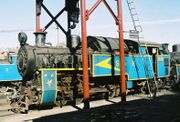
Nilgiri Mountain Railway X class
Encyclopedia
The X class locomotives are a class of metre gauge
0-8-2T rack and pinion compound locomotive
s working on the Nilgiri Mountain Railway
in the Nilgiri Hills of southern India
. They are used on the 20 km section between Coonoor
and Kallar where the gradient of the track can be as steep as 1 in 12.5. At these steep sections, the railway uses the Abt system. The X class locomotives are compound locomotive
s with two high-pressure and two low-pressure cylinders. All cylinders are outside the locomotive's frames. The two low-pressure cylinders drive the rack wheels. These cylinders are positioned above the two main high-pressure cylinders, which drive the main wheels.
Engines of this class were first brought as replacements for the line's original Beyer-Peacock
2-4-0 engines whose traction power was too weak for the traffic. The X class locos were bought in two batches from the Swiss Locomotive and Machine Works
, Winterthur, Switzerland. The first batch (12-nos.) were brought into operation over the years between 1920 and 1925 and the newer batch (5-nos.) in 1952.
 One locomotive, No. 37395, was modified changing it from coal to oil-fired in 2002, another has been modified and the Railway is looking to retro-fit further locomotives to oil-firing. Conversion of coal into oil-fired system has the potential to reduce the danger of forest fires that could be caused by embers flying out from the locomotive. Additionally, the effort involved in the manual lifting of coal and putting it into the boiler is eliminated. The current oil-fired locomotives need only one fireman to accompany the driver, while coal-fired engines need two firemen.
One locomotive, No. 37395, was modified changing it from coal to oil-fired in 2002, another has been modified and the Railway is looking to retro-fit further locomotives to oil-firing. Conversion of coal into oil-fired system has the potential to reduce the danger of forest fires that could be caused by embers flying out from the locomotive. Additionally, the effort involved in the manual lifting of coal and putting it into the boiler is eliminated. The current oil-fired locomotives need only one fireman to accompany the driver, while coal-fired engines need two firemen.
Metre gauge
Metre gauge refers to narrow gauge railways and tramways with a track gauge of . In some African, American and Asian countries it is the main gauge. In Europe it has been used for local railways in France, Germany, and Belgium, most of which were closed down in mid 20th century. Only in Switzerland...
0-8-2T rack and pinion compound locomotive
Compound locomotive
A compound engine unit is a type of steam engine where steam is expanded in two or more stages.A typical arrangement for a compound engine is that the steam is first expanded in a high-pressure cylinder, then having given up heat and losing pressure, it exhausts directly into one or more larger...
s working on the Nilgiri Mountain Railway
Nilgiri Mountain Railway
The Nilgiri Mountain Railway is a railway in Tamil Nadu, India, built by the British in 1908, and was initially operated by the Madras Railway Company. The railway still relies on its fleet of steam locomotives. NMR comes under the jurisdiction of the newly formed Salem Division...
in the Nilgiri Hills of southern India
India
India , officially the Republic of India , is a country in South Asia. It is the seventh-largest country by geographical area, the second-most populous country with over 1.2 billion people, and the most populous democracy in the world...
. They are used on the 20 km section between Coonoor
Coonoor
Coonoor is a town and a municipality in the Nilgiris district in the state of Tamil Nadu, India. It is known for its production of Nilgiri tea....
and Kallar where the gradient of the track can be as steep as 1 in 12.5. At these steep sections, the railway uses the Abt system. The X class locomotives are compound locomotive
Compound locomotive
A compound engine unit is a type of steam engine where steam is expanded in two or more stages.A typical arrangement for a compound engine is that the steam is first expanded in a high-pressure cylinder, then having given up heat and losing pressure, it exhausts directly into one or more larger...
s with two high-pressure and two low-pressure cylinders. All cylinders are outside the locomotive's frames. The two low-pressure cylinders drive the rack wheels. These cylinders are positioned above the two main high-pressure cylinders, which drive the main wheels.
Engines of this class were first brought as replacements for the line's original Beyer-Peacock
Beyer-Peacock
Beyer, Peacock and Company was an English railway Locomotive manufacturer with a factory in Gorton, Manchester. Founded by Charles Beyer and Richard Peacock, it traded from 1854 until 1966...
2-4-0 engines whose traction power was too weak for the traffic. The X class locos were bought in two batches from the Swiss Locomotive and Machine Works
Swiss Locomotive and Machine Works
Swiss Locomotive and Machine Works were a railway equipment manufacturer based in Winterthur in Switzerland...
, Winterthur, Switzerland. The first batch (12-nos.) were brought into operation over the years between 1920 and 1925 and the newer batch (5-nos.) in 1952.
| SLM Works Nos. | Year | Quantity | NMR No. | All India No. | Notes |
|---|---|---|---|---|---|
| 2456–2459, 2469–2470 | 1914 | 6 | 1–6 | 37384 | ex-No. 1 |
| 2734–2736, 2733 | 1920 | 4 | 7–10 | 37385–37388 | |
| 3000–3001 | 1925 | 2 | 11–12 | 37389–37390 | |
| 4069–4073 | 1952 | 5 | 13–17 | 37391–37395 | |
Replacements
Four new oil-fired steam locomotives have been ordered to replace or ease the load on the existing X class locomotives. They too will be of basically the same design as the existing locomotives and are also described as being of the X Class. The first of these arrived in 2011.Conversion to oil


